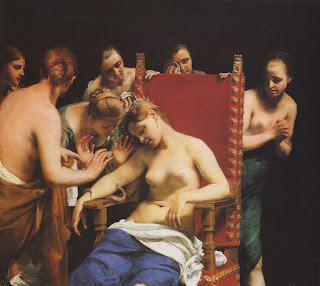My most recent book A History of the English Monarchy covers the English Crown from Roman rule to the death of Elizabeth I in 1603, when the monarchy began to shift into a British institution. Over the next few weeks, I'm posting short extracts from each of the book's seven chapters.
The book's third chapter is called From Scotland to Spain and it focuses on the early Plantagenet empire, which cover more of modern France than the then French monarchy. The English royal family's power and their dysfunction were both augmented by Henry II's glamorous and famous queen, Eleanor of Aquitaine. A reigning duchess in her own right, Eleanor's legend was born in her own lifetime thanks to the strength of her character and the scandals she managed to attract, then weather. The extract below discusses Eleanor's larger-than-life personality, which had been on display during her first marriage to King Louis VII of France. (It had ended in divorce and after an indecently short period, she married the future Henry II of England.)
Shortly after her marriage, King Louis [VI] died and Eleanor’s husband succeeded to the throne as Louis VII. Arriving in Paris for their coronation, Eleanor quickly discovered that she was no more popular with the French than Louis was with the Aquitinians. Her respected mother-in-law, Adélaïde of Maurienne, was ugly and pious; Eleanor was extravagant and said to be very beautiful. France hardly has a heart-warming history when it comes to its foreign-born queens consort, particularly if they happened to be pretty and had so much as a spark of a personality. It has already been mentioned that powerful clerics like Bernard of Clairvaux took issue with their new Queen’s pendulous earrings, but they also disliked her expensive jewellery, fur-trimmed silks and the long sleeves of her gowns. To them, and for whatever reason, the Queen’s wardrobe seemed indecent. She had been raised in a court that was comparatively more sophisticated and far wealthier than that of France. One contemporary noted that from childhood Eleanor had acquired ‘a taste for luxury and refinement’. Now that she was Queen, she saw absolutely no reason to tailor her whims to soothe the outrage of a few troublesome priests.
More damaging by far than her extravagance was Queen Eleanor’s passion for intrigue. Her younger sister Petronilla came to Paris with her and embarked upon an affair with the Comte de Vermandois, who was married. His wife, Éleonore, was King Stephen of England’s younger sister. That the Count was married to the sister of a King and that she had numerous powerful relatives at the French court should have warned Petronilla off her course of action. It should certainly have dissuaded Eleanor from stepping in to help her. However, Eleanor was close to her sister and she had a score to settle with the Comte de Champagne, King Stephen’s brother, who had recently opposed a French invasion of Toulouse, part of Eleanor’s patrimony, which she felt was being kept from her illegally. When news of the affair between Vermandois and Petronilla broke, Eleanor persuaded her husband to support Vermandois divorcing his wife to marry Petronilla. The clergy were appalled at the Queen’s actions and she gained a lifelong enemy in the Comte de Champagne, who regarded the divorce of his sister as a slight on his entire family. Champagne subsequently rebelled and many blamed Eleanor for provoking it. Criticised on all sides, the Queen brazenly refused to apologise and even publicly quarrelled with Bernard of Clairvaux when he declined to intercede with the Pope on Petronilla’s behalf. It was only when Eleanor began to fear that her continued childlessness was a sign of God’s displeasure that she began to improve her relationship with the Church.
It was during her first pregnancy, which she and those around her attributed to the intercession of the Blessèd Virgin, that news reached France that Edessa had fallen to the armies of Imad al-Din Zengi, the Islamic Emir of Mosul and Aleppo. Edessa was part of Outremer and its collapse prompted Pope Eugenius III to issue the Papal bull Quantum praedecessores, exhorting the Christian knights of Europe to ‘take the Cross’ and go east to defend the holiest sites of Christianity from falling into the hands of the non-believers. Both Louis and Eleanor were caught-up in the crusading fever and at Bernard of Clairvaux’s Easter sermon in praise of the sanctity of the Crusade, Eleanor knelt at her former opponent’s feet and pledged that the knights of the Aquitaine would take up their swords in the service of Christ. She, as their Duchess, would go with them.
It was not quite what Bernard had wanted from her. Like many of his contemporaries, the famous preacher neither liked nor trusted the idea of women anywhere near an army and Eleanor in particular worried him. However, the Queen had sworn publicly and she could not therefore be gainsaid. If she did not go, there was also every chance that the men of the Aquitaine would not go either, since going without their Duchess would mean submitting themselves entirely to the control of the French. One is tempted to think that Eleanor’s public gesture of commitment to the Crusade may therefore have been a deliberate ploy to bounce Bernard and her clerical opponents into giving their reluctant blessing to her participation. In any case, the Pope was keen to encourage maximum royal involvement in the holy war and his office formally blessed Eleanor and Louis in a ceremony at the basilica of St Denis shortly before they set off for Palestine. Having won a place for herself, Eleanor did nothing to dispel fears that she would prove a disruptive influence. She took nearly three hundred female servants with her and turned up for the army’s departure on a horse with a silver saddle encrusted with golden fleurs-de-lis and a dress glistening with jewels. She had many strengths. Minimalism was not one of them.






